We here in Great Britain heard a lot about the north-south divide back in the late 1970s and early 80s, only no one ever seemed to state exactly where the border between the two was. You could be forgiven for thinking that the south had all the yuppies and the north of Britain was unemployed. Thus most people in the south considered it to be "grim up north". Things are different these days.
Italy too, had a north-south divide. The only difference was that it was the north that was industrialized and rich and "Il relativo giù del sud torvo" - it was grim down south. The Italian government wanted to readdress the balance some what and came up with a scheme whereby companies would be given grants to set up in the south. Now, at the time Alfa Romeo, was still partly a state owned company so they were more or less obliged to do something in the south.
It just so happened that the company owned some land at Pomigliano d'Arco on the outskirts of Naples, where they manufactured aero engines. But what the company really wanted to do in Naples was manufacture cars. The matter in question was should they move one of the existing assembly lines south, and if so which one, or should they build a completely new product. The decision was taken to start from scratch with a new car. A car that would be known as the Alfasud - Alfa south.
Enter "The German"
Someone was needed to spearhead the project so, in 1968, Alfa called in an Austrian engineer by the name of Rudolf Hruska, a man whose portfolio included a long stint with Porsche and heavy involvement in the original VW Beetle. Hruska was given two blank pieces of paper and was told that he should use one to design a new small car and use the second to design the factory that it was to be built in! Read more about Alfa designers
Both of these tasks are major undertakings in their own right, but together would have caused a lesser man to run for the hills and live out the rest of his days as a hermit! However, the company did give Hurska some help - they gave him a secretary!
If such a project was undertaken today, there would be a team of engineers working on the design of the factory, another team working on engine, chassis and transmission development, and a group of stylists working on what the car should look like both inside and out. Hurska did all this himself and thus, in a very real sense, became the father of the Alfasud. There was some Italian input to the project by Georgetto Giugiaro, but all he did was some detail tidying of the design. Make no mistake, the Sud is Hurska's baby and his legacy to the Italian car industry. A legacy that was turned into reality in 1972 when the first Sud rolled off the production line.
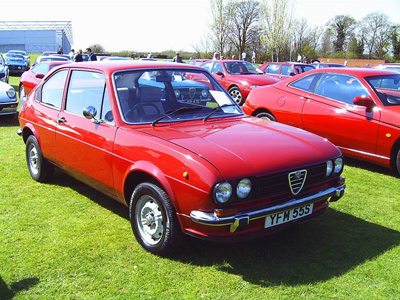
The early model TI. Possibly the definitive Sud. With the cleanest lines, it's easy to see Hureska's vision for what it is - another legendary Alfa Romeo.
|
Advanced Optimism
There were other factors in play here, as well, for Alfa Romeo had decided that nine in every 10 workers were to be recruited from the Naples area. A major training program was therefore called for. Plus the overall plan called for production of the Sud to be ramped up yearly to the point where one million cars would be produced annually. This was ambitious and, as history shows, never happened. The main cause of this has always been put down to labour problems and this is certainly part of the truth as members of the work force tended to go home on Thursday's and, feeling that they've done a decent weeks work, would take the Friday off. Plus, of course, there was one or two industrial disputes that halted production.
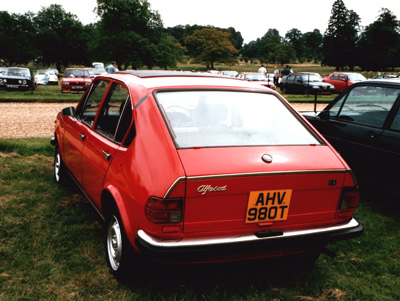
Early 1.3 model, note the small rear lights. Nearly all 1.3's have gone from British roads now.
|
The other reason had to be that the expected output from the factory was far too ambitious. As a company, Alfa had never come near to building one million cars in a single year. So, to expect one million cars to come out of one factory really was asking a great deal. Numerically, 1975 was the best year for production with around 103,000 cars (both the Sud & Sud Sprint) being produced. This was a long way short of what was expected. In fact, when the last Sprint rolled of the production line in 1989 it brought the total Sud & Sprint production to 1,015,153 cars.
The Models
A little over 21,000 people decided to experience Alfa's brave new world of front wheel drive in 1972. During this first year there was just a single model available. It was the first Alfa with front wheel drive, the first with a four cylinder opposed engine. Unlike other Alfas, the Sud had a four speed transmission, at least initially. This 'base' model, simply referred to as the Alfasud, would last until 1976 and, with nearly 180,000 units built, would become the most popular model. British buyers had to wait until 1973 for right-hand-drive examples, by which time the 2-door 1200Ti had been added to the range.
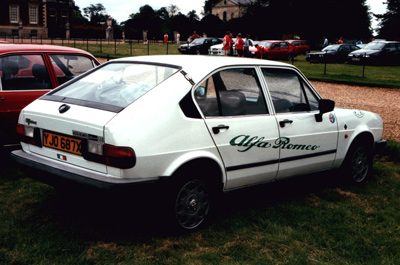
The late 1.3 models were never as popular as the Ti's. Note the larger rear lights on the later cars.
|
The Normale came along in 1974 and was more commonly referred to as the Alfasud N. This was shortly followed by the Alfasud L, or Lusso, and the 5M - with a five speed gearbox. Added to these was the SE which came about purely because some owners found the base model a little two basic! Thus, the SE received a tachometer, heated rear window, head rests, cigar lighter and a laminated front screen.
The next iteration of the range saw an introduction of the Super, which came in 1200, 1300 and 1500cc flavours, in both two and four door versions. Later, a 1350 Super would also be offered. These Supers took the Sud into the 1980s and were eventually discontinued in 1983. The 1350 engines were only available in SC models.
Special Editions
It was at the beginning of the 1980s when car makers first started to introduce the now common "special edition." Alfa Romeo were no different and saw it as a way to boost sales after the 1979 oil crisis. And with the Sud it was seen as a way of boosting the sale of a car that had already been in production for the best part of eight years. Two principle special editions were created. The Junior was aimed squarely at the younger driver/first car market in much the same way as the Giulia GT Junior had been back in the 1960’s. The Junior was, in effect, a 1200 Normale with the addition of a tricolour strip down the side. Twenty odd years later special editions haven't changed that much, have they!
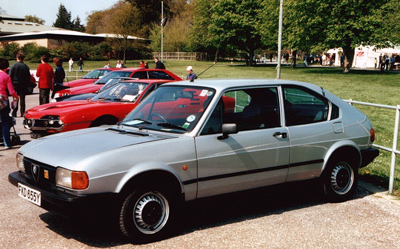
Non TI models such as this SC are now very rare on northern Europe roads now.
|
The other special edition to be lunched was possibly a first for any car maker; a special edition aimed at the female market. This was the Valantino and was available in 1200, 1300 and 1500cc versions. All Valantino came with metallic paint and a side strip that was extended up the rear quarter panel. The name Valantino also appeared on this rear panel. The strip could also be found on the boot along with a simple V. Inside, one could find acres of velour trim. Another Sud that can almost be described as a special edition was the Quadrofoligo Oro, of which nearly twelve thousand were produced between 1982 and 1983 and was effectively the range topping Sud.
Experimental Suds
There were a couple of other special editions that never made it onto the dealers forecourts. The first was the ESVAR which, clumsily, stood for Energy Saving Vehicle Alfa Romeo. This was no more than an experiment to produce an environmentally and passenger friendly vehicle. The engineers looked at all the factors that added to fuel consumption and then set about reducing rolling resistance, reducing weight, improving aerodynamics and changing gear ratios for optimum performance. An engine management system was developed that, amongst other things, was designed to shut down two cylinders when the engine was idling or under light load. The one underlying goal of this project was to develop technology that could be mass produced and used throughout the company's future product range.
The other experimental Sud was the Synthesis Vehicle Alfa Romeo or SVAR. With this vehicle, Alfa engineers were looking at something very different, namely safety. The SVAR had extra strengthening in the doors to help protect from side impacts. The engineers also looked at putting more strength in the roof as well as at the front and rear of the vehicle. The aim was to put the passengers in a box that could be as safe as was practical. The lessons learned from these two experimental vehicles are inherent in today's Alfa's so whether it's a Brera or a 147, the sprit of the Sud lives on.
Production Ends
1982 saw the biggest change in the range, ever. Up until now the Sud had officially be called a saloon. However, Alfa had finally listened to those who had complained about the fact that the boot lid needed to be rested against the rear window and produced a proper hatchback. However, times were moving on and the end of the road for the Alfasud was fast approaching. The ARNA and 33 were just around the corner and 1984 saw just 59 Suds roll off the production line. The final 16 Suds were produced in 1985 - the era had come to an end.
Alfasud Sprint
Up until now we have just concerned ourselves with Alfasud in saloon and hatchback form. But there was another significant Sud, the Alfasud Sprint. This first made its appearance back in 1976, and was intended as a latter day Giulietta Sprint replacement. Produced only as a 3-door hatchback, 121,434 examples were produced by the time production stopped in 1989.
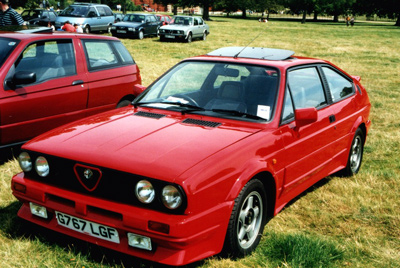
End of the line, the 1.7 Sprint Veloce. Late model Veloces had the wings and skirts as standard.
|
Sitting below the Alfetta GTV/GTV6 in the range, the initial Sprints were offered in 1300cc format. The Sprint was mechanically identical to the saloons. Body wise it was a very different animal, being 1 inch wider and 4 inches lower. And, were Giugiaro can only be credited with tidying the saloon, he can take full credit for the Sprint.
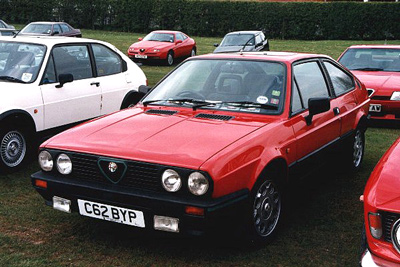
Late model Sprint Green Cloverleaf. The Sprint remained in production long after the Sud.
|
1982 saw the whole range (Sud & Sprint) updated. The chrome was out and the plastic was in. This gave the Sprint a fresh new look. The 1350cc engines were also discontinued, leaving the 1300 as the entry level sprint and the 1500 as the standard bearer. Eventually, the 1712cc engine would be dropped into the car, as well. Cloverleaf versions started to appear as well which had a green strip on the bumper and plastic side panels. Side skirts and a rear spoiler adorned the Veloce version.
After the Alfasud production stopped in 1985, the Sud name was also dropped from the Sprint. And it was known simply as the Alfa Romeo Sprint for the remainder of its production life.
Special editions of the Sprint were thin, the most prominent being the Sprint Trofeo. This was intended to provide a direct link between the Trofeo race cars that ran in the single make Trofeo series and the road cars. As a result, special graphics adorned the cars which today are very rare. This series was much like the 147 Challenge Cup that runs today. There was also a 1.5 Sprint Speciale produced that had an improved interior, better ventilation and a leather rimmed steering wheel.
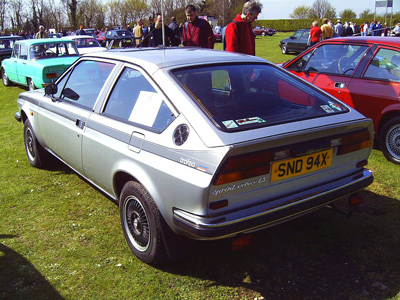
The only Sprint Trofeo in the United Kingdom. All Trofeo's had side strips like this one.
|
But it was in Veloce form that the Sprint proved to be most popular accounting for thirty percent of all Sprint production. First being introduced in 1980 in both 1300 and 1500 form, the 1300’s were slow sellers with only around 3800 being sold in a three year period. The 1500 Veloce on the other hand was far more popular, with Alfa building over 30,000 in the same three year period. And it was the 1712cc Veloce that finally brought the curtain down on production in 1989.
The Ultimate Sprint
Just like the ESVAR and SVAR Suds, there was one Sprint that never made it to the showrooms. This was the ultimate Sprint, the 6C. Alfa ripped out the boxer engine and chucked it over the nearest hedge. They did the same with the rear seats, as the space behind the front seats was needed for a V6 engine. The Sprint 6C was built in the spirit of the Group B rule book but was just a little bit more subtle than some of the other Group B cars. The 6C may never have made it into production, however there is a similar creation in existence. Rally driver Andy Burton campaigned a rear engined Sprint for a number of years in the British National series. However Burton's car had a Maranello sourced V8 in the back.
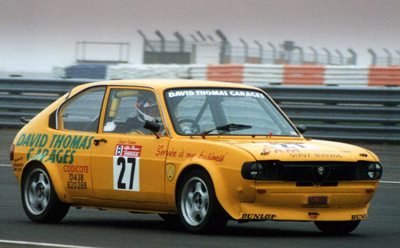
This modified Alfasud Ti raced in the English Alfa Romeo Championship. Driver David Thomas was crowned class champion in this car, here seen at Silverstone.
|
I had wanted to write this article without mentioning the word rust. However, I have to sadly concede that corrosion was a big part of the Alfasud ownership experience. This was especially so for those living in the United Kingdom. Cheap, low grade steel imported from Russia, combined with the copious amounts of salt that the authorities like to drop on British roads each winter did not bode well for the longevity of the Sud. Many cars, too many, in these islands succumbed to the corrosion which strangely tended to start high up and work its way down instead of the other way around.
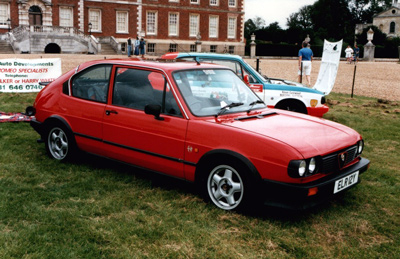
Late TI's like this one will set you back nearly as much as Alfetta GTV6's if in the right condition.
|
Some years ago I remember reading a quote about the Sud that went "all the bad ones have gone." That may have been true then, it's certainly true now. Long gone are the days when you could consider the Sud to be a cheap starter classic. Ten years ago they were almost two a penny in the classified section of Alfa club publications. They were so cheap that you probably would have bought two - the one that was described as "needs a good home" or "needs TLC", and the one that was "breaking for spares", and still have had change from £1500. And at the end of the day you would have ended up with one nice car. Them days are gone! A Sud being broken for spare is a rare find these days, as is an example for sale under £2500... I do believe that now we have, in the Alfasud, not just a classic car, but a legendary Alfa Romeo.



